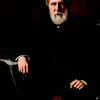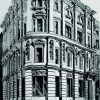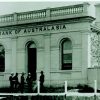The name Jacob Montefiore is synonymous with Montefiore Hill in North Adelaide, upon which the highly recognisable statue of Colonel William Light overlooks the city.
Montefiore was one of the eleven South Australian commissioners appointed by Colonial Secretary Lord Glenelg at the beginning of May 1835. However, Montefiore Hill could equally be named after the wider Montefiore family including Jacob’s younger brother, Joseph Barrow Montefiore, and their cousin, Sir Moses Montefiore. On Colonel Light’s original plan of the city of Adelaide a small, circular plot of land was set aside by the Street Naming Committee at the top of the rising ground behind what is now Adelaide Oval. Just adjacent to Jeffcott Street, the plot was the most salubrious place from which to view the whole of the city proper to the south It was not a street or a square but simply a small plot of land and a vantage point, which they called Montefiore, a name meaning ‘mount of flowers’.
Jacob Montefiore first appeared in and around the Adelphi in London as a member of the Provisional Committee of the South Australian Association, sometime between its first meeting on 2 December 1833 and the well-attended Exeter Hall meeting on 30 June 1834 – which by design immediately preceded the passage of the South Australia Act.
He was a young man in his early 30s and just what led him to become involved is speculative. However, if his much older (by sixteen years) cousin Sir Moses Montefiore, an extremely wealthy and previously highly influential member of the London Stock Exchange, is to be believed, it was he who put forward Jacob’s name to Secretary Thomas Spring Rice. Moses’s patronage probably helped Jacob receive the commission.
Jacob Montefiore, the eldest of three boys, came from a family of seventeen children. It is known that he had brothers, Joseph Barrow and John, and there were sisters, although some of the siblings sadly died in childhood. Jacob and his brother Joseph were both born in Bridgetown, Barbados, in 1801 and 1803 respectively. Their father, Eliezer Montefiore, was a successful merchant and sugar planter. At an early age, both boys returned to England to be educated. Joseph, it is reported, first went to Hurwitz’s Jewish school in Highgate, and then the Garcia Academy at Peckham. These schools were exclusively Jewish. It is presumed that Jacob may have also gone to the same institutions. Following their education, the two were inevitably drawn into some type of business, especially as they enjoyed the patronage of their older cousin Moses. For a time, Joseph was indentured to a London importing house which specialised in fine tea. In 1826 he purchased one of the twelve vacancies set aside for Jews on the London Stock Exchange, possibly the same seat his powerful older cousin had enjoyed prior to his retirement in the mid-1820s. It still cost Joseph £1,500 for the privilege. Jacob was attached to other Montefiore enterprises in London.
The Montefiores, all of them, formed part of an extended Italian–Jewish family which moved to Britain at the beginning of the eighteenth century but who spread their genes to the far-flung branches of the British Empire. By the beginning of the 1830s the wider family had become extremely wealthy, with an international network of colonial trade delivering huge returns. Their business activity extended as far as India, the Americas, the West Indies, New South Wales (NSW) and New Zealand. For the most part those of the family who ventured abroad were successful, taking measured risks in both merchandising and banking. Jacob and his younger brother Joseph were no exceptions.
Probably by mutual agreement between the brothers it was decided that Joseph would take his young family to NSW, where reports of large, fertile tracts of land being allocated to retired British officers and wealthy entrepreneurs had become legend. Bankrolled with at least £20,000, Joseph set up at least two branches of the House of Montefiore on arrival in Australia; one in Sydney and another in Van Diemen’s Land. The business focused on shipping and trading in the south seas.
Jacob remained in London seeking markets and outlets for their colonial produce, no doubt accounting for the description of his employment just prior to joining the South Australian Commission as a Trader in Colonial Produce.
In Sydney the young entrepreneurs established J.B. Montefiore & Co. in O’Connell Street. According to Dan Byrne’s website, Joseph initiated an embryonic branch structure of the Cornwall Bank in Sydney and Launceston.
Shortly after (in 1832), Thomas Potter MacQueen who, like the Montefiores, had money in the failed Swan River colony in Western Australia and who was an acquaintance of Joseph Montefiore in NSW, returned to England with two proposals for British investors. They were: a banking house and a south sea whaling operation. These initiatives were greeted enthusiastically and widely reported in the Sydney Gazette.
The Montefiore family in London immediately took up the banking house proposal and the Bank of Australasia launched. It was established in 1834–35 and administered by Jacob and the other directors from Threadneedle Street. They raised £20,000 as a float, some of it subscribed from colonists in NSW. This same bank grew to encompass a comprehensive branch structure throughout Australia and New Zealand and was one of the few overseas banks not to close during the bank crisis of 1893. Today it is Australia’s third biggest bank.
To explain why Jacob Montefiore was asked to join the Board of Commissioners for South Australia the following reasons are suggested. The ideologues within the South Australian Association were deeply perplexed when their first set of nominees, all liberals, partly collapsed following a change of ministry towards the end of 1834. George Grote, William Clay and Henry George Ward, all central figures in the original list, each withdrew on principle. They were not prepared to serve under a Tory ministry, albeit within a Commission which, by definition, was independent and at arm’s length from government. The South Australian Association decided to widen the representation of the proposed membership.
Under these circumstances a young, wealthy, influential Jew, who was not only interested in the project but also had existing commercial interests in Australia, was a desirable and highly likely candidate. Jacob Montefiore duly took his place among the commissioners.
Jacob Montefiore became totally engaged in the workings of the South Australian Commission. His contribution was all the more valuable because he was already part of a financial network in Australia and elsewhere, including India. The brothers were already directors of the Bank of Australasia and watching carefully for any financial opportunities which might arise. Perhaps more than coincidentally Brown reports on 27 October 1835 that ‘[t]he Australian Bank [Bank of Australasia] have liberally offered £20,000 Exchequer Bills on loan at 5% if when the loan is taken we require to give extra time for the first instalments’.
This was exactly the amount first subscribed and in the year the bank launched, suggesting that the brothers were keen to avail themselves of every opportunity to build their Australian enterprise. Apparently the offer from Jacob and his brother was on attractive terms and obviously designed to attract short-term, low-cost finance when the Commission needed to buy time.
After the Commission was gazetted, and during the mad scramble for appointments in the colony, Montefiore behaved with great integrity and was not at any time prepared to compromise Wakefield’s underlying theory. Like Wakefield he held strongly to the concept of ‘sufficient price’, believing it to be fundamental to the integrity of the colonial plan.
Jacob Montefiore maintained an interest in the colony throughout his life, even though he did not live there at any stage. He watched its fortunes and vicissitudes from a distance with much more than a passing financial interest.
When Governor John Hindmarsh sent Lieutenant W.G. Field to Sydney in command of the Rapid, in search of more surveyors and more surveying equipment, the Montefiore brothers had been appointed in both Sydney and Tasmania as agents to the colony, so they received the business.
When the colony of South Australia eventually collapsed financially, and spending had to be reined in by a determined but fair Governor Grey, it is worth following the fortunes of the two Montefiore brothers elsewhere in Australia.
By 1838 they had a 5,000-acre land grant in the Wellington Valley of NSW, where the Bell and Macquarie rivers meet. In absentia they ran large flocks of specially bred sheep from this enterprise. Mr Dalgety, the wool merchant of Melbourne’s Dalgety, Blackwood & Co., got his start in the business as a result of this enterprise. In the Wellington Valley the Montefiores gave generously to finance and built several places of worship, both Jewish and Christian. Throughout this early period Jacob remained in London as an absentee owner and director, while Joseph ran the Australian operation. Besides these pastoral interests they continued to expand the activities of the Bank of Australasia as well as open Melbourne’s first bank in 1838. A Tasmanian branch soon followed in Launceston. Other family enterprises included mining, transportation and whaling. There is some suggestion the Montefiores may have also dabbled in shipping. They obviously commissioned many ships in their day, consigning goods to be sent back to Britain and elsewhere.
Before the first ships were dispatched to South Australia by the Commission in 1836, Jacob Montefiore and George Palmer Jnr collaborated with Colonel Light on the fit-out of both survey ships, the Rapid and the Cygnet. Further business activity is also reported in The Australian, where there is a reference to the Australasian Steam Company to be administered by Jacob Montefiore in London and J.B Montefiore and T.C. Breillat in the colony, and a further notice about a meeting to consider the formation of a steam navigation company in Australia to be called the New South Wales Steam Navigation Company. Whether either or both of these projects eventuated is unknown. It must be said that about this time the two brothers became overstretched and fell into bankruptcy along with the rest of the country, and especially South Australia.
Though the brothers failed in 1840 there was always a fail-safe provision. Support from cousin Moses and others in the extended family was always a possibility and a fresh start inevitable. Jacob began by sailing to Australia to see his brother. In 1843 this brought him to Adelaide for the first time, to gain firsthand knowledge of the colony he had helped to establish. There is little doubt that he was also here to assess the whole country with a view to setting up business again on a surer footing.
By 1843 Adelaide’s economic outlook had begun to turn for the better. Jacob Montefiore arrived in mid-1843 to great pomp and circumstance. In a testimonial dinner to him at the Shakespeare Tavern, seventy of Adelaide’s finest gentlemen sat to a sumptuous meal. Chairman James Hurtle Fisher addressed those present, pointing out the value and vibrancy of Jacob’s earlier contribution to the South Australian Association and his powerful financial influence on the Board of Commissioners.
Jacob lived fleetingly in Australia but not until 1852, when he settled with his family in Melbourne as Australian agent for the Rothschilds. While there he joined the Victorian Institute for the Advancement of Science (recorded member in 1854), purchased land in his own name on the foreshore at Williamstown and continued to build up a portfolio elsewhere, in mining and real estate ventures.
He eventually returned to England, where he outlived all of those who were on the South Australian Commission. He was venerated at the Adelaide jubilee celebrations in 1887, when the population of Adelaide was reminded that he was still living at Hyde Park in London, noting that he was a committee member of the Royal Colonial Institute, a Fellow of the Royal Geographical Society in London and a Justice of the Peace. As part of the jubilee celebration a portrait of Jacob by artist B.S. Marks was commissioned at the request of the directors of the Art Union gallery of Adelaide. It was presented to the people of Adelaide in time for the jubilee in 1887 and is now part of the Art Gallery of South Australia Collection.
Jacob Montefiore died peacefully at his home in London on 3 November 1895.







Comments